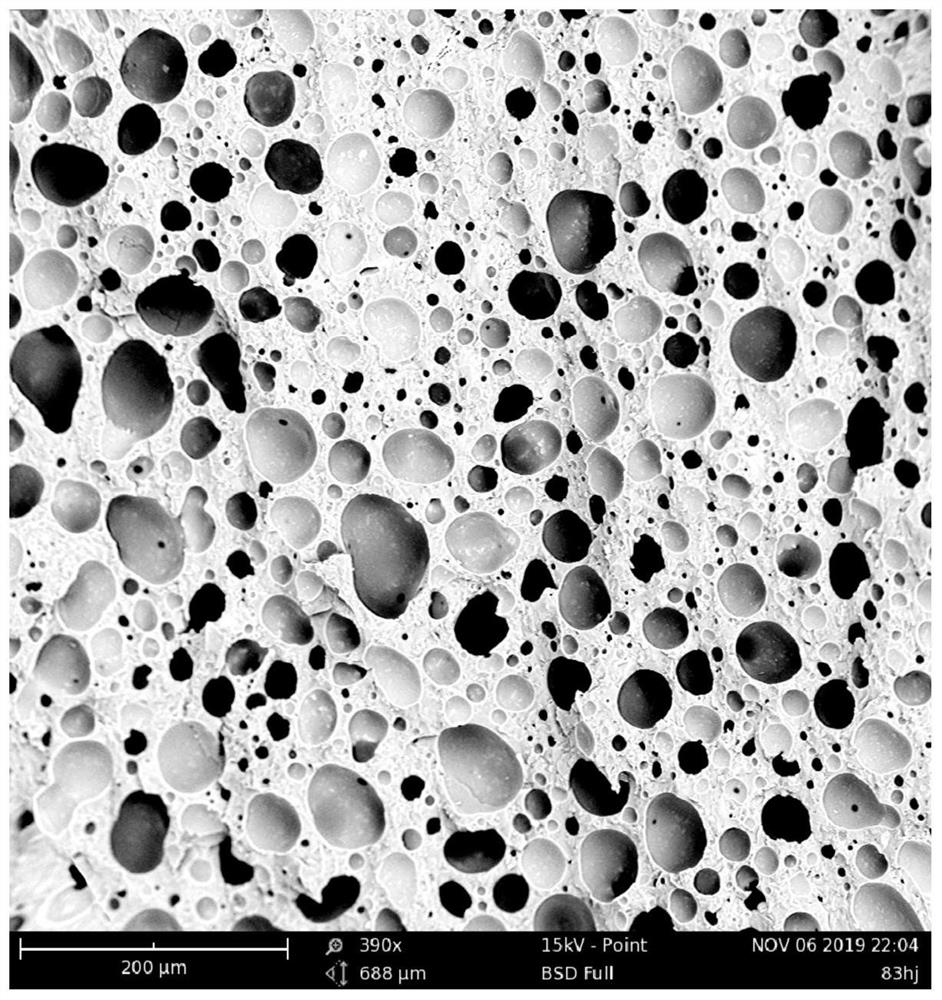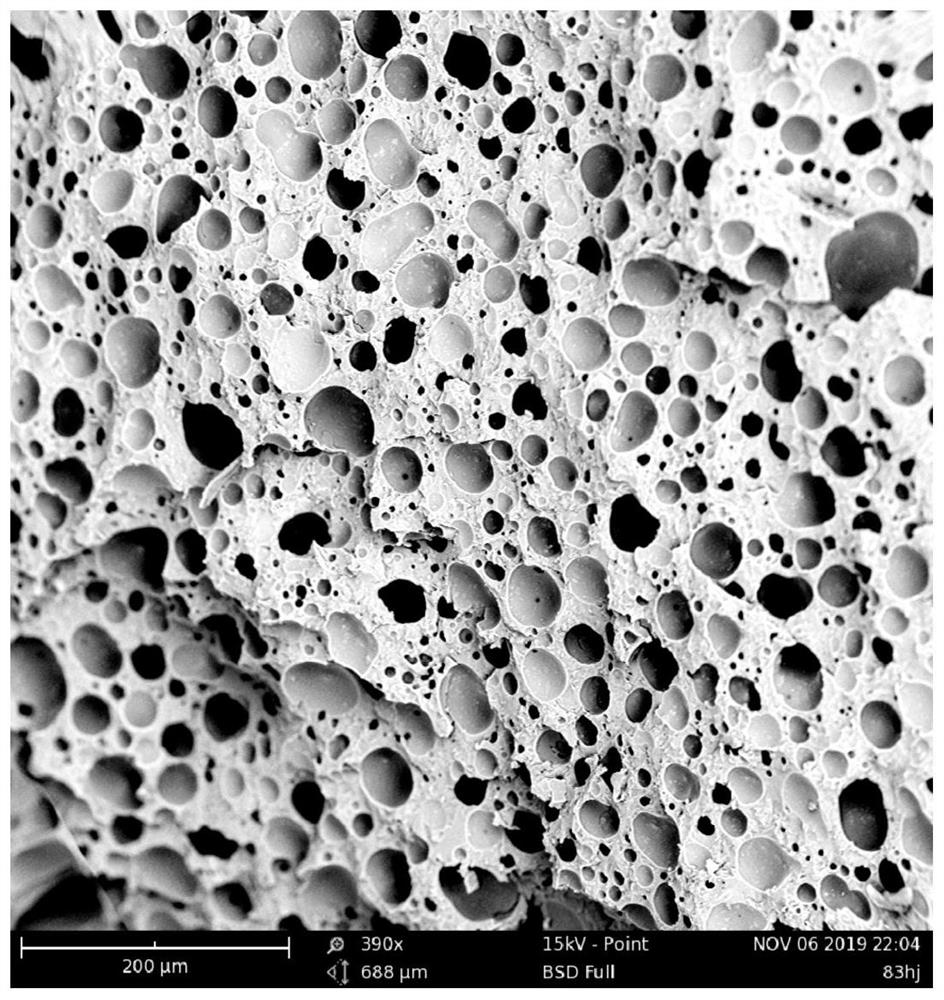Porous ceramic material pore-forming agent and preparation method thereof
A technology of porous ceramics and pore-forming agent, which is applied in the field of porous ceramic material pore-forming agent and its preparation, can solve the problems of difficult removal of inorganic pore-forming agent, difficulty in maintaining pore shape, influence of ceramic main body, etc., and achieves low cost and acceptable shape. Control, no bad residue effect
- Summary
- Abstract
- Description
- Claims
- Application Information
AI Technical Summary
Problems solved by technology
Method used
Image
Examples
Embodiment 1
[0033] (1) heat-treat rice husks at 600° C. for 4 hours in an air atmosphere, and cool to room temperature with the furnace to obtain the first product;
[0034] (2) Put the first product into a planetary ball mill for crushing, then pass through a 5000-mesh sieve to obtain the second product;
[0035] (3) The second product is spray-dried and granulated, first passed through a 300-mesh sieve, and then passed through a 325-mesh material, and the obtained non-permeable material is the porous ceramic material with a particle size of 40-50 μm for pore making The agent is detected by X-ray photoelectron spectroscopy and consists of: carbon 27wt%, silicon dioxide 67.4wt%, calcium chloride 2.2wt%, ferric chloride 0.1wt% and potassium chloride 3.3wt%; the planetary formula The parameters of the ball mill are: the distribution balls are 6mm ceramic balls, the speed ratio: rotation:revolution is 2:1, the revolution speed is 200rpm, and the ball milling time is 12h; The feed speed is 5...
Embodiment 2
[0038] (1) heat-treat rice husks at 600°C for 2.5 hours in an air atmosphere, and cool to room temperature with the furnace to obtain the first product;
[0039] (2) Put the first product into a planetary ball mill for crushing, then pass through a 5000-mesh sieve to obtain the second product;
[0040] (3) The second product is spray-dried and granulated, first passed through a 300-mesh sieve, and then passed through a 325-mesh material, and the obtained non-permeable material is the porous ceramic material with a particle size of 40-50 μm for pore making The agent is detected by X-ray photoelectron spectroscopy and consists of: carbon 28wt%, silicon dioxide 66.4wt%, calcium chloride 2.18wt%, ferric chloride 0.12wt% and potassium chloride 3.3wt%; the above-mentioned planet The parameters of the type ball mill are: the matching balls are 6mm ceramic balls, the speed ratio: rotation:revolution is 2:1, the revolution speed is 200rpm, and the ball milling time is 12h; the process ...
Embodiment 3
[0043] (1) heat-treat rice husks at 600° C. for 1 hour in an air atmosphere, and cool to room temperature with the furnace to obtain the first product;
[0044] (2) Put the first product into a planetary ball mill for crushing, then pass through a 5000-mesh sieve to obtain the second product;
[0045] (3) The second product is spray-dried and granulated, first passed through a 300-mesh sieve, and then passed through a 325-mesh material, and the obtained non-permeable material is the porous ceramic material with a particle size of 40-50 μm for pore making Agent, which is composed of 28.5wt% carbon, 65.9wt% silicon dioxide, 2.18wt% calcium chloride, 0.12wt% iron trichloride and 3.3wt% potassium chloride by X-ray photoelectron spectroscopy; The parameters of the type ball mill are: the matching balls are 6mm ceramic balls, the speed ratio: rotation:revolution is 2:1, the revolution speed is 200rpm, and the ball milling time is 12h; the process parameters of the above spray drying...
PUM
| Property | Measurement | Unit |
|---|---|---|
| Particle size | aaaaa | aaaaa |
| Compressive strength | aaaaa | aaaaa |
| Flexural strength | aaaaa | aaaaa |
Abstract
Description
Claims
Application Information
 Login to View More
Login to View More - Generate Ideas
- Intellectual Property
- Life Sciences
- Materials
- Tech Scout
- Unparalleled Data Quality
- Higher Quality Content
- 60% Fewer Hallucinations
Browse by: Latest US Patents, China's latest patents, Technical Efficacy Thesaurus, Application Domain, Technology Topic, Popular Technical Reports.
© 2025 PatSnap. All rights reserved.Legal|Privacy policy|Modern Slavery Act Transparency Statement|Sitemap|About US| Contact US: help@patsnap.com



